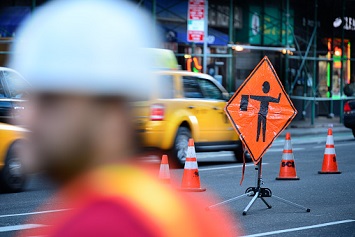The latest trend in safety for construction workers may have been established by a New York City (NYC) law signed by Mayor Bill de Blasio in October 2017. Local Law 196 established new training requirements for employees at certain construction jobsites. The requirement—a minimum number of hours of training on specific safety subjects for workers and their supervisors—is now in effect and will become more stringent over the next year.
Some of the requirements can be satisfied through two OSHA programs, called OSHA 10-Hour (OSHA 10) and OSHA 30-Hour (OSHA 30). Many OSHA standards compel employers to train their employees, but there is no requirement that this be done with OSHA 10 or OSHA 30 courses. Furthermore, Local Law 196 requires that safety-course providers be approved by New York’s Department of Buildings (DOB).
Safety in the construction sector is a major issue in New York State (NYS). The topic has been tracked by the New York Committee for Occupational Safety and Health (NYCOSH). In a January 2018 report, NYCOSH said the previous year had seen an “epidemic of construction fatalities,” mainly outside NYC. The city itself had seen a 21 percent decrease in construction fatalities over the previous 5 years. Most fatalities involved falls from high-rise construction projects. The report noted that the decrease in fatalities in the city could be attributed to a “dramatically increasing numbers of inspections” by the DOB. Conversely, in the remainder of the state, which does not have an equivalent agency, NYCOSH says fatalities were at a record high.
When fully phased in, Local Law 196 will require that workers and supervisors at construction jobsites where city regulations require that a construction superintendent, site safety coordinator, or site safety manager be designated receive specified hours of safety training. Those not requiring training include delivery persons, flag persons, professional engineers, and registered architects. Also, training is not required for workers at jobsites that involve only minor alterations or the construction of new one-, two-, or three-family homes.
OSHA-Required Training
Many OSHA standards covering worksites with hazardous conditions require some form of training for employees. For example, OSHA’s standard for steel erection (29 CFR 1926.761) requires that employers establish a training program and ensure that employees are trained by qualified persons. Training must cover fall hazards and how to avoid falls. At29 CFR 1926.32(m), OSHA defines a “qualified person” as an individual “who, by possession of a recognized degree, certificate or professional standing, or who by extensive knowledge, training and experience, has successfully demonstrated his ability to solve or resolve problems relating to the subject matter, the work, or the project.”
Temporary SST (10-hour) Card
As of March 1, 2018, the following training, at a minimum, was required:
- An OSHA 10-hour class (this will qualify the worker for a Temporary Site Safety Training (SST) card; an SST card is issued by a training provider indicating that an individual has completed a specified level of training);
- An OSHA 30-hour class; or
- A 100-hour training program approved by the DOB.
Limited SST (30-hour) Card
The SST OSHA 10 Card expires after 6 months. On December 1, 2018 (or June 1, 2019, if the DOB determines that there is insufficient capacity to provide the training), workers will be required to have a Limited SST Card, which indicates one of the following:
- The OSHA 10 class has been completed plus 20 hours of additional training comprising 8-hour fall protection, 8-hour site safety manager refresher, and 4-hour supported scaffold user and refresher.
- The OSHA 30 class has been completed.
- A 100-hour training program approved by the DOB has been completed. (Completion, at a minimum, means the satisfaction of coursework in either of the two items above.)
- The employee has the required prior experience. (The DOB explains prior experience as follows: “An applicant for an SST Card, including a Limited SST Card, SST Card or Supervisor SST Card, who completed the training to comply with the requirements for that card, but who did not complete a particular course topic within the five years preceding submission of an application for an SST Card, must complete the following training in the one-year period preceding submission of an application for an SST Card: 4-Hour Fall Prevention and 4-Hour Supported Scaffold User.”)
SST Supervisor (62-hour) Card
On December 1, 2018 (or June 1, 2019, if the DOB determines that there is insufficient capacity to provide the training), supervisors will be required to have an SST Supervisor Card, which requires at a minimum the following 62 hours of training:
- OSHA 30 hour
- 8-hour fall prevention
- 8-hour site safety manager refresher
- 4-hour supported scaffold user
- 2-hour site safety plan
- 2-hour toolbox talks
- 2-hour pretask safety meetings
- 2-hour drug and alcohol awareness
- 2-hour general electives selected from a list provided by the DOB
- 2-hour specialized electives selected from a list provided by the DOB
The SST Supervisor Card expires after 5 years and is renewable upon applicants showing that they have completed 16 training hours specified by the DOB in the 1-year period preceding submission of a renewal application. This training must comprise, at a minimum, 8 hours of fall protection, 4 hours of support scaffold user and refresher, 2 hours of toolbox talk, and 2 hours of pretask safety meetings.
SST (40-hour) Card
Effective May 1, 2019, or September 1, 2020, workers must have an SST Card indicating completion of one of the following:
- OSHA 10 class with 30 hours of additional training comprising:
- 8-hour fall prevention
- 8-hour site safety manager refresher
- 4-hour supported scaffold user and refresher
- 4-hour general electives selected from a list provided by the DOB
- 4-hour specialized electives selected from a list provided by the DOB
- 2-hour drug and alcohol awareness
- OSHA 30 class with 10 hours of additional training comprising:
- 8-hour fall prevention
- 2-hour drug and alcohol awareness
- 100-hour training program approved by the DOB, which, at a minimum, meets the coursework in either of the two above items; or
- Prior experience as defined above.
The SST Card expires after 5 years and is renewable upon applicants showing they have completed 4 hours of fall prevention and 4 hours of supported scaffold user and refresher.
Venue
As of October 16, 2017, only in-person training and actively proctored online training is accepted. Actively proctored online training is:
- Online training that is taken in a classroom with a proctor; or
- Online training that at a minimum requires the individual receiving the training to attest that he or she is the individual who received the training and that the training was received without assistance; his or her participation must be monitored at random times to ensure that the individual receiving the training is present for the entirety of the training.
Enforcement
Applicants for DOB permits will be required to certify to the DOB that workers who will be working under the permit will have the requisite training. If the DOB discovers that workers at a construction site are untrained, it will issue a notice of violation (NOV), carrying with it a civil penalty as high as $5,000 per untrained worker, to the owner of the site, the permit holder, and the employer of the untrained worker. These civil penalties can be mitigated if an employer sponsors training for such untrained worker. If the DOB discovers that a permit holder has failed to maintain a log that demonstrated that all of the workers at a site are trained, the DOB will issue an NOV, carrying with it a civil penalty of $2,500. The DOB adds that it intends to conduct unannounced inspections at sites where untrained workers have been discovered.
SST Cards
Upon completion of a course, the course provider must issue a wallet-sized SST Card that must include, at a minimum, the following information:
- Security features designed to deter forgery and counterfeiting
- Unique identification (ID) card number
- Photograph of the person to whom it was issued
- The printed name and signature of the card holder
- Date of course completion
- Expiration date
- Name and address of provider of issuance
- A summary of the type of training and number of credit hours completed
Course Providers
The DOB requires that course providers have documentation indicating that they meet at least one of the following qualifications:
- Approved by the NYS Department of Education, such as through a registered NYS Department of Labor vocational, trade, or apprenticeship program;
- Certified by an accrediting organization recognized by the American National Standards Institute (ANSI) as a Standards Developing Organization with published standards for continuing education and training;
- Licensed as an educational institution by the NYS Department of Education; or
- Accredited by an accrediting organization recognized by the U.S. Department of Education or the Council for Higher Education.
Recordkeeping
The course provider must maintain a record of all issued Temporary SST Cards, Limited SST Cards, SST Cards, or Supervisor SST Cards for a minimum of 7 years.
The course provider must maintain a secure online verification system containing an up-to-date list of the name of the card holder, the unique ID card number, and the issuance and expiration date of the card. Such verification must be available to the city, including the DOB, and contractors to enable readily accessible confirmation of the names of card holders who have completed training through the particular course provider.


